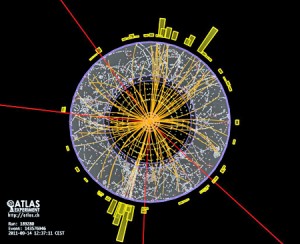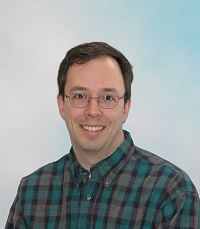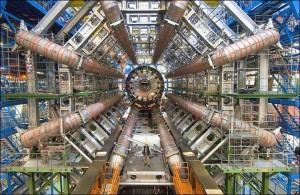
An event with four identified muons from a proton-proton collision in ATLAS. Such events are produced by Standard Model processes without Higgs particles. They are also a possible signature for Higgs particle production, but many events must be analysed together in order to tell if there is a Higgs signal. - Click photo for larger version (Photo: ATLAS Collaboration)
A definitive answer on whether or not the so-called “God Particle” exists could come in 2012, according to a scientist involved in solving the mystery.
The search for the subatomic particle called the Higgs boson went into overdrive in 2008, when the European Organization for Nuclear Research, or CERN, in Switzerland switched on its sophisticated atom smasher called the Large Hadron Collider (LHC) .
Results of the CERN experiments, known as Atlas and CMS, were announced recently at a seminar.
Rumor was that the Higgs boson had finally been found. Instead, the teams revealed they’d found tantalizing hints of where the Higgs boson may be found, if it exists at all.
Dr. Pierre Savard, associate professor of physics at the University of Toronto, is currently involved in the Atlas experiments to track down the elusive particle. He says that before each experimental team revealed its findings, neither knew the other’s results.
Once those results were revealed, it became clear both the Atlas and CMS experiments pointed to “a certain excess of events at a certain mass, and that the two sets of results were consistent with each other.”

Dr. Pierre Savard (Photo: University of Toronto)
One reason scientists hope to find the Higgs boson is because of the critical role it’s believed to play in physics; as a building block of the universe.
The Standard Model of particle physics provides an explanation for sub-nuclear physics, and some aspects of cosmology in the earliest moments of the universe. In the standard model, it’s the Higgs boson that gives mass to all particles.
Despite the recent CERN findings, there are those who remain skeptical that while the Higgs boson may exist it will never be found, while others doubt its existence at all.
“The evidence is quite interesting, but it’s not completely convincing, so the conclusive evidence will come in 2012 if there is a Higgs boson,” Dr. Savard says. “But it’s possible that what we saw was just a big statistical fluctuation and it’s not really there.”
If the Higgs boson is not found researchers would have to go back to the drawing board. In effect, Dr. Savard says, no Higgs boson, no mass, no universe.
“So if the electron didn’t have a mass, for instance, we wouldn’t have hydrogen, wouldn’t have atoms and we wouldn’t be around.”
Without the Higgs boson, the current explanation within the Standard Model of how particles acquire mass is wrong. On the other hand, Dr. Savard says, if the mysterious sub-atomic particle is found in the course of the ongoing experiments and the teams are able to confirm that it behaves like the Standard Model hypothesized, then the mechanism for giving particles mass would also be probably found.
Dr. Savard believes scientists are closing in on determining whether the Higgs boson is real.
“We’re quite close. The Large Hadron Collider is working very well, and right now it’s in a shut-down period for three months and we’ll start taking data in March.”
According to Dr. Savard, the important thing to emerge from the recent findings is that both the Atlas and CMS experiments have the sensitivity to make a conclusive determination of whether the Higgs boson is there or not, and that within six or nine months after the LHC goes back on line, the experiments should have a definite answer.
Dr. Pierre Savard joins us this weekend on the radio edition of “Science World.” He’ll give us some insight into the search for the elusive Higgs boson. Tune in (see right column for scheduled times) or check out the interview below.
[audio://blogs.voanews.com/science-world/files/2011/12/One-On-One-Dr.-Pierre-Savard-Higgs-Boson.mp3|titles=One On One – Dr. Pierre Savard – Higgs Boson]Other stories we cover on the “Science World” radio program this week include:
- Zimbabwe’s indigenous forests are rapidly disappearing
- Rwandan doctors treat children with an assist from US specialists
- Vietnamese farmers use wasps instead of pesticides to protect rice crops
- Keeping rural doctors from fleeing to the big city






















How can a proton have a mass <1,800 the Higg's boson. I had understood that the only particle that had mass the Higg's.